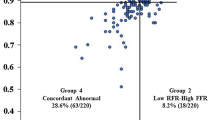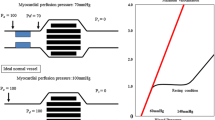Abstract
Instantaneous wave-free ratio (iFR) is a vasodilator-free index and is reported to have a good correlation with fractional flow reserve (FFR). Hemodialysis patients exhibit left ventricular hypertrophy, reduced arterial compliance, and impaired microcirculation. Such a coronary flow condition in these patients may influence the relationship between iFR and FFR. This study assessed the impact of hemodialysis on the relationship between iFR and FFR. The study enrolled 196 patients with 265 stenoses who underwent assessment via iFR, FFR assessment, and right heart catheterization. A good correlation between iFR and FFR was observed in hemodialysis patients. iFR in the hemodialysis group was significantly lower than in the non-hemodialysis group (0.81 ± 0.13 vs. 0.86 ± 0.13, p = 0.005), although no significant difference was found in FFR and percentage diameter stenosis. An iFR value of 0.84 was found to be equivalent to an FFR value of 0.8 in hemodialysis patients, which was lower than the standard predictive iFR range for ischemia. Vasodilator-free assessment by iFR could be beneficial in evaluating intermediate coronary stenosis in patients receiving hemodialysis. However, the threshold for iFR abnormality needs adjustment in hemodialysis patients, and larger clinical trials are required to confirm the results in this specific subset.




Similar content being viewed by others
References
Japanese Society for Dialysis Therapy. The illustrated, overview of regular dialysis treatment in Japan. Jpn Soc Dial Ther. 2014. http://docs.jsdt.or.jp/overview/index.html. Accessed Nov 2016.
Sarnak MJ, Levey AS, Schoolwerth AC, Coresh J, Culleton B, Hamm LL, et al. Kidney disease as a risk factor for development of cardiovascular disease—a statement from the American Heart Association Councils on Kidney in Cardiovascular Disease, High Blood Pressure Research, Clinical Cardiology, and Epidemiology and Prevention. Circulation. 2003;108:2154–69.
Cheung AK, Sarnak MJ, Yan G, Dwyer JT, Heyka RJ, Rocco MV, Levey AS, et al. Atherosclerotic cardiovascular disease risks in chronic hemodialysis patients. Kidney Int. 2000;58:353–62.
Miyagi N, Arai H. What is optimal revascularization for hemodialysis patients? Circ J. 2012;76:1085–6.
Higashitani M, Mori F, Yamada N, Arashi H, Kojika A, Hoshi H, et al. Efficacy of paclitaxel-eluting stent implantation in hemodialysis patients. Heart Vessels. 2011;26:582–9.
Tonino PA, Fearon WF, De Bruyne B, Oldroyd KG, Leesar MA, Ver Lee PN, et al. Angiographic versus functional severity of coronary artery stenoses in the fame study fractional flow reserve versus angiography in multivessel evaluation. J Am Coll Cardiol. 2010;55:2816–21.
Shaw LJ, Berman DS, Maron DJ, Mancini GB, Hayes SW, Hartigan PM, COURAGE Investigators, et al. Optimal medical therapy with or without percutaneous coronary intervention to reduce ischemic burden: results from the clinical outcomes utilizing revascularization and aggressive drug evaluation (courage) trial nuclear substudy. Circulation. 2008;117:1283–91.
Pijls NH, De Bruyne B, Peels K, Voort PH, Bonnier HJ, Bartunek J, et al. Measurement of fractional flow reserve to assess the functional severity of coronary-artery stenosis. N Engl J Med. 1996;334:1703–8.
De Bruyne B, Pijls NH, Kalesan B, Barbato E, Tonino PA, Piroth Z, FAME 2 Trial Investigators, et al. Fractional flow reserve-guided PCI versus medical therapy in stable coronary disease. N Engl J Med. 2012;367:991–1001.
De Bruyne B, Fearon WF, Pijls NH, Barbato E, Tonino P, Piroth Z, FAME 2 Trial Investigators, et al. Fractional flow reserve-guided PCI for stable coronary artery disease. N Engl J Med. 2014;371:1208–17.
Pijls NH, van Schaardenburgh P, Manoharan G, Boersma E, Bech JW, van’t Veer M, et al. Percutaneous coronary intervention of functionally nonsignificant stenosis: 5-year follow-up of the defer study. J Am Coll Cardiol. 2007;49:2105–11.
Matsuo A, Fujita H, Ueoka A, Maruyama N, Shimoda Y, Kishita E, et al. Importance of measuring the fractional flow reserve in patients receiving hemodialysis. Cardiovasc Interv Ther. 2011;26:215–21.
Sen S, Escaned J, Malik IS, Mikhail GW, Foale RA, Mila R, et al. Development and validation of a new adenosine-independent index of stenosis severity from coronary wave-intensity analysis: results of the ADVISE (adenosine vasodilator independent stenosis evaluation) study. J Am Coll Cardiol. 2012;59:1392–402.
Petraco R, Escaned J, Sen S, Nijjer S, Asrress KN, Echavarria-Pinto, et al. Classification performance of instantaneous wave-free ratio (iFR) and fractional flow reserve in a clinical population of intermediate coronary stenoses: results of the ADVISE registry. EuroIntervention. 2013;9:91–101.
Petraco R, Park JJ, Sen S, Nijjer SS, Malik IS, Echavarria-Pinto M, et al. Hybrid iFR–FFR decision-making strategy: implications for enhancing universal adoption of physiology-guided coronary revascularisation. EuroIntervention. 2013;8:1157–65.
Sen S, Asrress KN, Nijjer S, Petraco R, Malik IS, Foale RA, et al. Diagnostic classification of the instantaneous wave-free ratio is equivalent to fractional flow reserve and is not improved with adenosine administration. Results of clarify (classification accuracy of pressure-only ratios against indices using flow study). J Am Coll Cardiol. 2013;61:1409–20.
Petraco R, Al-Lamee R, Gotberg M, Sharp A, Hellig F, Nijjer SS, et al. Real-time use of instantaneous wave-free ratio: results of the ADVISE in-practice: an international, multicenter evaluation of instantaneous wave-free ratio in clinical practice. Am Heart J. 2014;168:739–48.
Harle T, Bojara W, Meyer S, Elsasser A. Comparison of instantaneous wave-free ratio (iFR) and fractional flow reserve (FFR)—first real world experience. Int J Cardiol. 2015;199:1–7.
McIntyre CW, Burton JO, Selby NM, Leccisotti L, Korsheed S, Baker CS, et al. Hemodialysis-induced cardiac dysfunction is associated with an acute reduction in global and segmental myocardial blood flow. Clin J Am Soc Nephrol. 2008;3:19–26.
Miyazaki H, Matsuoka H, Itabe H, Usui M, Ueda S, Okuda S, et al. Hemodialysis impairs endothelial function via oxidative stress-effects of vitamin E-coated dialyzer. Circulation. 2000;101:1002–6.
Klocke FJ. Measurements of coronary flow reserve: defining pathophysiology versus making decisions about patient care. Circulation. 1987;76:1183–9.
Hamasaki S, Suwaidi JA, Higano ST, Miyauchi K, Holmes DR Jr, Lerman A. Attenuated coronary flow reserve and vascular remodeling in patients with hypertension and left ventricular hypertrophy. J Am Coll Cardiol. 2000;35:1654–60.
Gould KL. Pressure-flow characteristics of coronary stenoses in unsedated dogs at rest and during coronary vasodilation. Circ Res. 1978;43:242–53.
Nijjer S, Waard G, Sen S, van de Hoef Tim P, Petraco R, Echavarría-Pinto, et al. Coronary pressure and flow relationships in humans: phasic analysis of normal and pathological vessels and the implications for stenosis assessment: a report from the Iberian–Dutch–English (IDEAL) collaborators. Eur Heart J. 2016;37:2069–80.
Perera D, Biggart S, Postema P, Patel S, Lambiase P, Marber M, et al. Right atrial pressure: can it be ignored when calculating fractional flow reserve and collateral flow index? J Am Coll Cardiol. 2004;44:2089–91.
Toth GG, De Bruyne B, Rusinaru D, Gioia GD, Bartunek J, Pellicano M, et al. Impact of right atrial pressure on fractional flow reserve measurements comparison of fractional flow reserve and myocardial fractional flow reserve in 1,600 coronary stenoses. J Am Coll Cardiol Interv. 2016;9:453–9.
Author information
Authors and Affiliations
Corresponding author
Ethics declarations
Conflict of interest
All authors have no conflicts of interest to declare.
Funding
This study was not financially supported by any company, grant, or fund.
Rights and permissions
About this article
Cite this article
Morioka, Y., Arashi, H., Otsuki, H. et al. Relationship between instantaneous wave-free ratio and fractional flow reserve in patients receiving hemodialysis. Cardiovasc Interv and Ther 33, 256–263 (2018). https://doi.org/10.1007/s12928-017-0479-4
Received:
Accepted:
Published:
Issue Date:
DOI: https://doi.org/10.1007/s12928-017-0479-4




